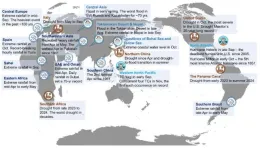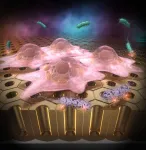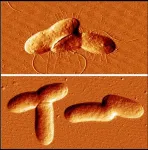(Press-News.org)
From the persistent droughts of southern Africa and Central America in the early part of the year to the more recent devastating extreme rainfall in Spain and the deadly Hurricane Helene along America’s east coast, 2024 has been a year of climate events that affected the lives of billions of people.
In a recent paper published in Advances in Atmospheric Sciences, an international team of scientists led by Dr Wenxia Zhang at the Institute of Atmospheric Physics, Chinese Academy of Sciences, provide an overview of the characteristics and impacts of the most notable extreme events of the year, including rainfall and flooding, tropical cyclones, and droughts. Moreover, they discuss their causes, the role of global warming, and the challenges we face in the future to be “climate-resilient”. Dr Zhang and her team have been conducting an annual review of the global climate extremes since 2022, and this year they found it to be marked by exceptional rainfall and flooding.
“Most extreme events have a large random element in that they are subject to fluctuations in the weather, and occur when weather patterns set up in just the 'right' way. Some extremes are more likely when larger-scale drivers such as ENSO influence the weather patterns in a region,” says Dr James Risbey at CSIRO, coauthor of the study.
In particular, many of the extreme rainfall and drought events of 2024 were related to the atmospheric configurations associated with the El Niño in winter 2023/24. However, ENSO does not fully explain individual events. Layered on top of that, according to studies of extreme event attribution, or “attribution science”, we know that human-induced climate change since the pre-industrial era has in many cases exacerbated extreme rainfall, tropical cyclones, and droughts, and therefore their associated socioeconomic impacts.
“The climate change influence can be direct through physical processes causing the extreme, or indirect in influencing the weather, large scale drivers, and key baselines,” adds Dr Risbey.
“This is consistent with basic physical understanding that anthropogenic warming leads to increases in atmospheric moisture and evaporative demand, and hence, potentially enhances extreme rainfall and droughts, respectively”, explains Dr Wenxia Zhang.
Despite our understanding of why the world is experiencing increasingly strong and frequent extreme climate events, the research team behind this study make it clear that key challenges remain in our knowledge and attribution of these phenomena—not least the often seen inconsistencies between observed and modeled extremes (especially for extreme rainfall), which limits our confidence in attribution results.
“Improved extreme event attribution requires better understanding of climate change”, says Dr Micheal Brody of George Mason University (USA) and the International Agricultural University (Uzbekistan), another of the paper’s authors. “More accurate attribution of extreme events is expected to inform decision-making, ranging from post-disaster recovery to future preparedness”.
Another crucial angle to this annually developing story of our climate is our ability to accurately forecast and broadcast the occurrence of extreme events, and then to act appropriately. Doing so could save many of the lives of the people that otherwise fall victim to the floods and hurricanes like those seen in 2024.
“Some of the extreme events witnessed in 2024, such as Hurricane Helene, were well forecasted”, notes Dr Zhuo Wang from the University of Illinois, another member of the team. “The destructive impacts were partly due to the vulnerability of the underprepared community to a changing climate”.
Dr Piotr Wolski, University of Cape Town, adds: “Increasing the quality of forecasts is important, but to reduce the impacts of extreme events, it is more important to achieve proper dissemination of warnings and to act upon them to lessen existing vulnerabilities”.
Dr Wolski's comments refer to the idea of being “climate-resilient”, which is fast becoming a crucial aspect in our holistic approach to climate change and the effects it is having on our society. As we shift to a feeling of almost inevitability that this is our world now, there is a rising sense of what can be done to protect ourselves alongside how to prevent the problem in the first place.
As we saw in Valencia, Spain, following the devastating floods and mudslides there in October, it does not take much for the impacts of extreme climate events to manifest as frustration and anger among the people affected.
Clearly, it is more urgent than ever to not only work towards better understanding the drivers of extreme weather and climate, but also to better predict their occurrence and develop effective systems to rapidly act upon the information at hand.
Only then can we be better prepared for years like 2024.
END
Tokyo, Japan – Researchers from Tokyo Metropolitan University have created nanostructured alumina surfaces which are strongly antibacterial but can be used to culture cells. They found that anodic porous alumina (APA) surfaces prepared using electrochemistry in concentrated sulfuric acid had unprecedented resistance to bacterial growth, but did not hamper cell cultures. The team’s technology promises to have a big impact on regenerative medicine, where high quality cell cultures without bacterial contamination may be produced without ...
A new tablet combining albendazole and ivermectin is safe and more effective than albendazole alone in treating Trichuris trichiura and other soil-transmitted helminths (STH), according to a clinical trial conducted by the STOP consortium and led by the Barcelona Institute of Global Health (ISGlobal), a centre supported by “la Caixa” Foundation. The findings, published in The Lancet Infectious Diseases, open opportunities to improve the control of these neglected tropical infections, which affect around ...
In an effort to close the gap in neurological outcomes for underserved populations, a UTHealth Houston project funded with $2.9 million from the National Institutes of Health (NIH) will engage community partners to improve the design of clinical trials.
Neurologic conditions including stroke, Parkinson’s disease, and vascular cognitive impairment and dementia contribute to the leading causes of death and disability in the U.S. The goal of the project is to build an infrastructure for community-engaged research interventions for those three neurologic conditions affecting brain health.
“Historically, clinical trials for neurological conditions haven’t ...
Depression can affect anyone. It is common, and in many cases severe. These days, there are good treatments available, typically involving a combination of psychotherapy and medication. However, finding the right treatment can take some time. Not everyone responds equally well to every medication. Researchers at six European university medical centers, led by Charité – Universitätsmedizin Berlin, teamed up to accelerate the process of arriving at solid findings relating to both new and known treatments. The key will be a joint study design, supported over the ...
Researchers from the Hong Kong Polytechnic University, alongside mainland collaborators, have uncovered an unexpected phenomenon: severe wintertime ozone (O₃) pollution in Lanzhou, China, driven primarily by alkene emissions from local petrochemical industries. Traditionally associated with warm weather and strong solar radiation, hourly O₃ levels exceeding 100 ppbv were recorded during cold January days in 2018, peaking at an alarming 121 ppbv.
Using an advanced photochemical box model, the study identified alkene ozonolysis as ...
East Hanover, NJ – January 10, 2025 – The employment-to-population ratio for people with disabilities has remained stable over the past 15 months amid historically high levels, with recent data suggesting a modest but encouraging upward trend, according to today’s January 2025 National Trends in Disability Employment monthly update (nTIDE) issued by Kessler Foundation and the University of New Hampshire’s Institute on Disability (UNH-IOD).
Month-to-Month nTIDE Numbers (comparing November 2024 to December 2024)
Based on data from the U.S. Bureau of Labor Statistics (BLS) ...
A recent commentary article by researchers from Northwestern University, Harvard University, and The University of Texas at San Antonio highlights the significant but overlooked environmental and social impacts of Generative Artificial Intelligence (GenAI). Published in Environmental Science and Ecotechnology, the research underscores the urgent need for sustainable practices and ethical governance as GenAI technologies proliferate.
The study reveals the environmental toll of GenAI development, with hardware production such as GPUs and data centers consuming ...
FOR IMMEDIATE RELEASE
January 10, 2025
Contact:
Jillian McKoy, jpmckoy@bu.edu
Michael Saunders, msaunder@bu.edu
##
Lower Access to Air Conditioning May Increase Need for Emergency Care for Wildfire Smoke Exposure
As Los Angeles County battles the most destructive wildfires in its history, a new study suggest that US policies should prioritize equity and education regarding the measures people can take to protect themselves from the harmful pollutants in wildfire smoke.
People who have limited access to air ...
If your teeth have ever felt fuzzy after skipping a brushing, you’ve encountered biofilm—a slimy bacterial layer that clings to surfaces. In medical settings, biofilms make infections harder to treat when they form protective shields for bacteria on devices like catheters and implants.
UC Riverside scientists have now discovered a chemical that plants produce when they're stressed prevents biofilm from forming. The breakthrough offers potential advances in healthcare as well as preventing equipment corrosion in industrial settings.
“In simple terms, biofilms are communities ...
Hinda and Arthur Marcus Institute for Aging Research investigators at Hebrew SeniorLife have launched a large clinical food trial to test whether a combination of probiotics and prebiotics (BondiaÒ or SBD111) developed by Solarea Bio will help manage bone health in women aged 60 years and above. The first participants have joined the study and the Institute seeks additional women for the 18-month effort.
“I am very happy to be involved in this important research to help with bone health in women,” says study participant Kathy ...




